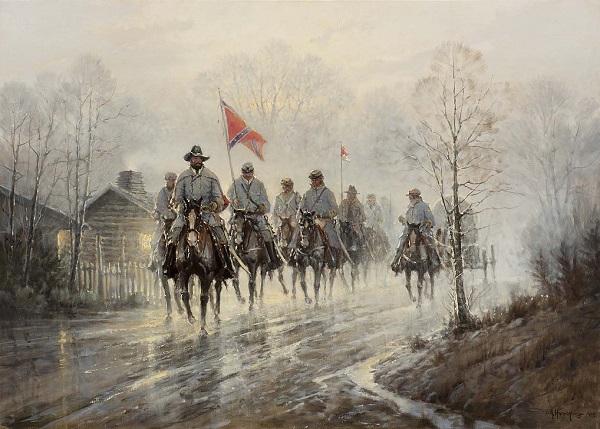Holding the Center
January - March 1862
 Shermans march through Arkansas
Shermans march through Arkansas
As 1862 opened, it was decided in a meeting between the three main generals of the Confederacy that Shermans march through the western states had to be stopped if it was not to undermine the progress that had been made in the east. As such, Generals Jackson, Stuart and newcomer Rand McLaws were sent with a total of just over 62,000 men westward to Nashville and Tuscaloosa in order to prepare.
Lee and his 37,000 men stayed in the east in order to retake the regions already taken by the Union and to counter Grants inevitable attempts to make further gains albeit with fewer forces after the recent Confederate successes.

However, a new concern was being raised in the Confederate capital of Richmond, and that was the shrinking budget which despite the best attempts of the men who knew the ins and outs of finances, would just not lift out of its negative spiral towards the red.
It was with a heavy heart and much cussing of the damyankees and their blockade that Christopher Memminger, the Secretary of the Treasury, authorised the acquisition of several loans in order to assist with the war effort. It was hoped that the number and size of the loans would only be small since, so far, the war was balanced slightly in the Confederacies favour, however no-one could be sure exactly how the next year would pan out.
The Second Battle of Fredericksburg
 The First New Jersey Brigade charges the Confederate lines
The First New Jersey Brigade charges the Confederate lines
In late January 1862, Grant moved south again pulling with him men of the Washington garrison after being driven out of Virginia by the combined forces of Lee, Jackson and Stuart last year. Hoping, perhaps, to take advantage of Jackson and Stuart redeploying westward and Lee focusing on retaking lost territory he moved fast and started capturing Fredericksburg.
However, Lee decided to split his forces after he successfully retook Staunton, sending 14,000 north-east to Manassas and taking 23,000 with him to Fredericksburg to attack Grant.

Battle commenced on the evening of the 2nd of Feburary 1862, with Grants forces initially having the upper hand due to having dug in whilst waiting for the inevitable attack. However the difference in size between the forces soon took its toll and despite some brave efforts on the behalf of the New Jersey brigade to try and break through Lees lines, the Union forces collapsed completely and by the 19th Feburary the Washington Garrison had been all but annihilated with minimal losses to the Confederate forces.

Meanwhile in Europe, more chaos was unfolding as France and Prussia, with its Germanic state allies, went to war with each other.

This was good and bad news for the Confederacy, good in that it was unlikely that the French would now seek to work with the Union against them, but bad in that it also made it more unlikely that Great Britain would join their side whilst such uncertainty ruled in Western Europe.
In the beginning of March, whilst the 14,000 men that split from Lees force continued to occupy Manassas Lee moved through to Staunton where a small Union force was attempting to force its way into Virginia, it was composed primarily of artillery and was quickly swept aside in a battle that lasted no more than a day.

Lee then pushed forward into Roanoke where another 8,000 Union forces awaited him. The forces in Roanoke put up a much larger fight than those in Staunton however the outcome was still the same. Lees much larger force drove them from the field with high casualties on the 22nd March 1862.

Meanwhile in the west, Shermans forces moved into Okmulgee while Stuart and Jackson prepared to march and do battle with him. It was estimated that Stuart would arrive first on the 25th March and Jackson would arrive shortly after on the 5th April. Shermans forces had reinforced to 43,000 men, so it was clear that a titanic battle awaited them.
 General J.E.B. Stuart marching through western Arkansas to do battle with Sherman.
General J.E.B. Stuart marching through western Arkansas to do battle with Sherman.